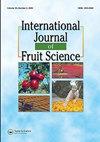尼日利亚西南部芒果品种的表型和分子特征
IF 2.5
3区 农林科学
Q2 HORTICULTURE
引用次数: 5
摘要
形态和微卫星(SSR)标记是确定芒果品种间遗传亲缘关系的有效工具。本研究使用了17个芒果品种。收集8个果实数量性状,采用单因素方差分析(One-Way ANOVA)进行平均分离,主成分分析(PCA)进行相关分析。同时,利用基于pcr的SSR标记进行分子分析。利用数值分类和多元分析系统(NTSYSpc)对所得二值矩阵进行分析。8个数量性状在17个芒果品种间存在显著差异(p≤0.05)。主成分分析表明,果实长度、宽度、厚度、重量、果肉百分比和果核百分比占所有芒果品种变异的98.73%。7个多态性引物共检测到21个等位基因,每个位点检测到2 ~ 5个等位基因,平均每个位点检测到3.0个等位基因。多态性信息含量(PIC)在0.52 ~ 0.80之间,平均为0.66。形态和分子标记均表明,芒果品种除“西贡”和“朱莉”、“哈登”和“利彭”外,其他品种均具有多样性,虽然根据未研究性状在形态上存在差异,但通过分子分析,它们具有很强的相似性。利用基于SSR标记的UPGMA (Unweighted Pair Group with Arithmetic mean)方法构建的树图显示,相似系数为48 ~ 93%,表明变异程度高,存在近交现象。形态学和微卫星(SSR)分析结果表明,本研究所用芒果品种间存在广泛的多样性。本文章由计算机程序翻译,如有差异,请以英文原文为准。
Phenotypic and Molecular Characterization of Mango Cultivars in Southwest Nigeria
ABSTRACT Morphological and microsatellites (SSR) markers are efficient tools for determining genetic relatedness among mango cultivars. Seventeen mango cultivars were used for this study. Eight fruit quantitative traits were collected and subjected to mean separation using One-Way ANOVA and correlation using Principal Component Analysis (PCA). Also, molecular analysis was done using PCR-based SSR markers. The resulting binary matrix was analyzed using Numerical Taxonomy and Multivariate Analysis System (NTSYSpc). Significant variation (p ≤ .05) among all the 17 mango cultivars was observed for the eight quantitative traits studied. The PCA showed that the fruits length, width, thickness weights, %pulp and %stone contributed to 98.73% of the variation observed in all the mango cultivars. A total of 21 alleles were detected from the seven polymorphic primers ranging from two to five alleles per locus with an average of 3.0 alleles per locus. The polymorphic information content (PIC) ranged from 0.52 to 0.80 with an average of 0.66. Both the morphological and molecular markers showed that the mango cultivars were diverse except for ‘Saigon’ and ‘Julie’ as well as ‘Harden’ and ‘Lipen’ which though appear morphologically distinct based on the understudied traits but showed strong similarity to each other through molecular analysis. Dendrogram constructed using the Unweighted Pair Group Method with Arithmetic mean (UPGMA) based on SSR markers revealed a similarity coefficient of 48–93% indicating high level of variability and the presence of outbreeding. Results of the morphological and microsatellite (SSR) analyses showed wide diversity among the mango cultivar used in this study.
求助全文
通过发布文献求助,成功后即可免费获取论文全文。
去求助
来源期刊

International Journal of Fruit Science
Agricultural and Biological Sciences-Agronomy and Crop Science
CiteScore
6.40
自引率
0.00%
发文量
64
审稿时长
10 weeks
期刊介绍:
The International Journal of Fruit Science disseminates results of current research that are immediately applicable to the grower, extension agent, and educator in a useful, legitimate, and scientific format. The focus of the journal is on new technologies and innovative approaches to the management and marketing of all types of fruits. It provides practical and fundamental information necessary for the superior growth and quality of fruit crops.
This journal examines fruit growing from a wide range of aspects, including:
-genetics and breeding
-pruning and training
-entomology, plant pathology, and weed science
-physiology and cultural practices
-marketing and economics
-fruit production, harvesting, and postharvest
 求助内容:
求助内容: 应助结果提醒方式:
应助结果提醒方式:


